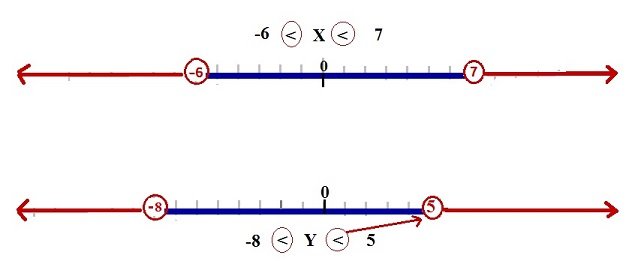CAMANISHPARMAR wrote:
If -6 < X < 7 and -8 < Y < 5, which of the following specifies all the possible values of XY ?
A) -56 < XY < 35
B) -48 < XY < 35
C) -28 < XY < 56
D) -56 < XY < 48
E) -48 < XY < 48
Attachment:
 inequanumbline.jpg [ 20.94 KiB | Viewed 2068 times ]
inequanumbline.jpg [ 20.94 KiB | Viewed 2068 times ]
Sandy56 wrote:
I dont understand. The question did not say that X is less than OR EQUAL TO -6 or more than or equal to 7 , so we shouldn't count -6 and 7 as a possibility of x right? Same goes for Y
Sandy56 , I think you got confused about what a strict inequality means.
Actually, maybe just confused about inequality, full stop.
Inequalities are occasionally disorienting. Too, I might be missing something.
The prompt defines the possible values of X and Y in terms of strict inequalities.
Less than and NEVER equal to: <
Greater than and NEVER equal to: >
Another way to understand "strict inequality"
The strict inequality signs < and > mean that the variable can never equal the number next to it
Strict inequalities do not look like this: ≤ ≥
Quote:
The question did not say that X is less than OR EQUAL TO -6 or more than or equal to 7
Of course the prompt did NOT say that X is less than or equal to -6
Why would the prompt say the opposite of what the inequality indicates? (Wow am I perplexed.

)
The
strict inequality that defines the values of X is -6 < X < 7
X is greater than and never/not equal to -6, and X is less than and not equal to 7
Possible values of X can fall only in the range between -6 and 7
Given the inequality's range of possible values for X, how could X be equal to -6, less than -6, equal to 7, or greater than 7?
The prompt says none of the possibilities you suggest because if it were to say any of those things, it would render the inequalities meaningless.
(Okay, now I am overboard. Prompts do not talk. Run with it.)
Number lines (diagram) offer a graphic representation of the inequalities that define permissible and impermissible ranges for values of X and Y
Possible values for X or Y: BLUE
X and Y cannot fall in the ranges that are RED; nor can the variables equal the circled numbers
Circled numbers give us the values that X and Y must be
between X and Y cannot hop over, disregard, or obliterate their boundaries.
If a strict inequality gives a range of possible values for X, that range IS all the possible values.
I hope that helps.




 35%
(medium)
35%
(medium)
 41%
(01:41)
wrong
41%
(01:41)
wrong  based on 108
sessions
based on 108
sessions

